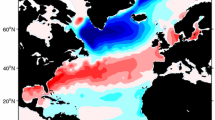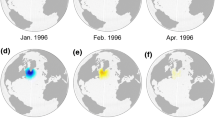Abstract
Recent studies have indicated that the multidecadal variations of the Atlantic Warm Pool (AWP) can induce a significant freshwater change in the tropical North Atlantic Ocean. In this paper, the potential effect of the AWP-induced freshwater flux on the Atlantic Meridional Overturning Circulation (AMOC) is studied by performing a series of ocean–sea ice model experiments. Our model experiments demonstrate that ocean response to the anomalous AWP-induced freshwater flux is primarily dominated by the basin-scale gyre circulation adjustments with a time scale of about two decades. The positive (negative) freshwater anomaly leads to an anticyclonic (cyclonic) circulation overlapping the subtropical gyre. This strengthens (weakens) the Gulf Stream and the recirculation in the interior ocean, thus increases warm (cold) water advection to the north and decreases cold (warm) water advection to the south, producing an upper ocean temperature dipole in the midlatitude. As the freshwater (salty water) is advected to the North Atlantic deep convection region, the AMOC and its associated northward heat transport gradually decreases (increases), which in turn lead to an inter-hemispheric SST seesaw. In the equilibrium state, a comma-shaped SST anomaly pattern develops in the extratropical region, with the largest amplitude over the subpolar region and an extension along the east side of the basin and into the subtropical North Atlantic. Based on our model experiments, we argue that the multidecadal AWP-induced freshwater flux can affect the AMOC, which plays a negative feedback role that acts to recover the AMOC after it is weakened or strengthened. The sensitivity of AMOC response to the AWP-induced freshwater forcing amplitude is also examined and discussed.


















Similar content being viewed by others
References
Bell GD, Chelliah M (2006) Leading tropical modes associated with interannual and multidecadal fluctuations in north Atlantic hurricane activity. J Clim 19:590–612
Clement AC, Peterson LC (2008) Mechanisms of abrupt climate change of the last glacial period. Rev Geophys 46:RG4002. doi:10.1029/2006RG000204
Compo GP et al (2011) The twentieth century reanalysis project. Q J R Meteorol Soc 137:1–28
Danabasoglu G, Bates SC, Briegleb BP, Jayne SR, Jochum M, Large WG, Peacock Synte, Yeager SG (2012) The CCSM4 ocean component. J Clim 25:1361–1389
Delworth TL, Mann ME (2000) Observed and simulated multidecadal variability in the Northern Hemisphere. Clim Dyn 16:661–676
Delworth TL, Manabe S, Stouffer RJ (1993) Interdecadal variation in the thermohaline circulation in a coupled ocean atmosphere model. J Clim 6:1993–2011
Deshayes J, Frankignoul C (2008) Simulated variability of the circulation of the North Atlantic from 1953 to 2003. J Clim 21:4919–4933
Dickson R, Lazier J, Meincke J, Rhines P, Swift J (1996) Long term coordinated changes in the convective activity of the North Atlantic. Prog Oceanogr 38:241–295
Dijkstra HA, Te Raa LA, Schmeits M, Gerrits J (2006) On the physics of the Atlantic multidecadal oscillation. Ocean Dyn 56:36–50
Dong BW, Sutton RT (2002) Adjustment of the coupled ocean–atmosphere system to a sudden change in the thermohaline circulation. Geophys Res Lett 29:1728. doi:10.1029/2002GL015229
Eden C, Willebrand J (2001) Mechanisms of interannual to decadal variability of the North Atlantic circulation. J Clim 14:2266–2280
Enfield DB, Lee SK (2005) The heat balance of the Western Hemisphere warm pool. J Clim 18:2662–2681
Enfield DB, Mestas-Nunez AM, Trimble PJ (2001) The Atlantic multidecadal oscillation and its relationship to rainfall and river flows in the continental US. Geophys Res Lett 28:2077–2080
Ganachaud A, Wunsch C (2000) Improved estimates of global ocean circulation, heat transport and mixing from hydrological data. Nature 408:453–457
Goldenberg SB, Landsea C, Mestas-Nunez AM, Gray WM (2001) The recent increase in Atlantic hurricane activity. Science 293:474–479
Häkkinen S (1999) Variability of the simulated meridional heat transport in the North Atlantic for the period 1951–1993. J Geophys Res 104:10991–11007
Huang B, Mehta VM (2004) Response of the Indo-Pacific warm pool to interannual variations in net atmospheric freshwater. J Geophys Res 109:C06022. doi:10.1029/2003JC002114
Huang B, Mehta VM (2005) Response of the Pacific and Atlantic Oceans to interannual variations in net atmospheric freshwater. J Geophys Res 110:C08008. doi:10.1029/2004JC002830
Huang B, Mehta VM, Schneider N (2005) Oceanic response to idealized net atmospheric freshwater in the Pacific at the decadal time scale. J Phys Oceanogr 35:2467–2486
Kanzow T et al (2010) Seasonal variability of the Atlantic meridional overturning circulation at 26.5°N. J Clim 23:5678–5698
Knight JR et al (2005) A signature of persistent natural thermohaline circulation cycles in observed climate. Geophys Res Lett 32. doi:10.1029/2005GL024233
Krebs U, Timmermann A (2007a) Fast advective recovery of the Atlantic meridional overturning circulation after a Heinrich event. Paleoceanography 22. doi:10.1029/2005PA001259
Krebs U, Timmermann A (2007b) Tropical air–sea interactions accelerate the recovery of the Atlantic Meridional overturning circulation after a major shutdown. J Climate 20:4940–4956
Large WG, Yeager SG (2009) The global climatology of an interannually varying air–sea flux data set. Clim Dyn 33:341–364
Lavender KL, Davis RE, Owens WB (2002) Observations of open-ocean deep convection in the Labrador Sea from subsurface floats. J Phys Oceanogr 32:511–526
Lee SK, Wang C (2010) Delayed advective oscillation of the Atlantic thermohaline circulation. J Clim 23:1254–1261
Lee SK, Enfield DB, Wang C (2007) What drives seasonal onset and decay of the Western Hemisphere warm pool? J Clim 20:2133–2146
Liu Z (1999) Forced planetary wave response in a thermocline gyre. J Phys Oceanogr 29:1036–1055
Lumpkin R, Speer K (2007) Global ocean meridional overturning. J Phys Oceanogr 37:2550–2562
Manabe S, Stouffer RJ (1995) Simulation of abrupt climate change induced by freshwater input to the North Atlantic ocean. Nature 378:165–167
Manabe S, Stouffer RJ (1999a) The role of thermohaline circulation in climate. Tellus 51A:91–109
Manabe S, Stouffer RJ (1999b) Are two modes of thermohaline circulation stable? Tellus 51A:400–411
McCabe G, Palecki M, Betancourt J (2004) Pacific and Atlantic Ocean influences on multidecadal drought frequency in the United States. Proc Nat Acad Sci 101:4136–4141
Medhaug I, Furevik T (2011) North Atlantic 20th century multidecadal variability in coupled climate models: sea surface temperature and ocean overturning circulation. Ocean Sci Discuss 8:353–396
Medhaug I, Langehaug HR, Eldevik T, Furevik T, Bentsen M (2012) Mechanisms for decadal scale variability in a simulated Atlantic meridional overturning circulation. Clim Dyn 39:77–93
Msadek R, Frankignoul C (2009) Atlantic multidecadal oceanic variability and its influence on the atmosphere in a climate model. Clim Dyn 33:45–62
Okumura Y, Deser C, Hu A, Timmerman A, Xie S (2009) North Pacific climate response to freshwater forcing in the Subartic North Atlantic: ocean and atmospheric pathways. J Clim 22:1424–1445
Park W, Latif M (2012) Atlantic meridional overturning circulation response to idealized external forcing. Clim Dyn 39:1709–1726. doi:10.1007/s00382-011-1212-0
Pickart RS, Spall MA, Ribergaard MH, Moore GWK, Milliff RF (2002) Deep convection in the Irminger sea forced by the Greenland tip jet. Nature 424:152–156
Smith TM, Reynolds RW, Peterson TC, Lawrimore J (2008) Improvements to NOAA’s Historical Merged Land-Ocean Surface Temperature Analysis (1880–2006). J Clim 21:2283–2296
Stouffer RJ, Seidov D, Haupt BJ (2007) Climate response to external sources of freshwater: North Atlantic versus the Southern Ocean. J. Climate 20:436–448
te Raa LA, Dijkstra HA (2002) Instability of the thermohaline ocean circulation on interdecadal timescales. J Phys Oceanogr 32:138–160
Timmermann A, An S, Krebs U, Goosse H (2005) ENSO suppression due to a weakening of the North Atlantic thermohaline circulation. J Clim 18:3122–3139
Vellinga M, Wu P (2004) Low-latitude freshwater influence on centennial variability of the Atlantic thermohaline circulation. J Clim 17:4498–4511
Wang C, Enfield DB (2001) The tropical Western Hemisphere warm pool. Geophys Res Lett 28:1635–1638
Wang C, Enfield DB (2003) A further study of the tropical Western Hemisphere warm pool. J Clim 16:1476–1493
Wang C, Lee SK (2009) Co-variability of tropical cyclones in the North Atlantic and the eastern North Pacific. Geophy Res Lett 36:L24702. doi:10.1029/2009GL041469
Wang C, Zhang L (2013) Multidecadal ocean temperature and salinity variability in the tropical North Atlantic: linking with the AMO, AMOC and subtropical cell. J Clim (in press)
Wang C, Lee SK, Enfield DB (2008a) Climate response to anomalously large and small Atlantic warm pools during the summer. J Clim 21:2437–2450
Wang C, Lee SK, Enfield DB (2008b) Atlantic warm pool acting as a link between Atlantic multidecadal oscillation and Atlantic tropical cyclone activity. Geochem Geophys Geosyst 9:Q05V03. doi:10.1029/2007GC001809
Wang C, Liu H, Lee SK, Atlas R (2011) Impact of the Atlantic warm pool on United States landfalling hurricanes. Geophys Res Let. doi:10.1029/2011GL049265
Wang C, Zhang L, Lee SK (2013) Response of freshwater flux and sea surface salinity to variability of the Atlantic warm pool. J Clim 26:1249–1267
Wu L, Li C, Yang C, Xie SP (2008) Global teleconnections in response to a shutdown of the Atlantic meridional overturning circulation. J Clim 21:3002–3019
Zhang R-H, Busalacchi AJ (2009) Freshwater Flux (FWF)-Induced Oceanic feedback in a hybrid coupled model of the tropical Pacific. J Climate 22:853–879
Zhang R, Delworth T (2005) Simulated tropical response to a substantial weakening of the Atlantic thermohaline circulation. J Clim 18:1853–1860
Zhang L, Wang C (2012) Remote influences on freshwater flux variability in the Atlantic warm pool region. Geophys Res Lett 39:L19714. doi:10.1029/2012GL053530
Zhang L, Wu L (2012) Can oceanic freshwater flux amplify global warming? J Clim 25:3417–3430
Zhang R, Delworth TL, Held IM (2007) Can the Atlantic Ocean drive the observed multidecadal variability in Northern Hemisphere mean temperature? Geophys Res Lett 34:L02709. doi:10.1029/2006GL028683
Zhang L, Wu L, Zhang J (2011a) Coupled ocean-atmosphere responses to recent freshwater flux changes over the Kuroshio-Oyashio extension region. J Clim 24:1507–1524
Zhang L, Wu L, Zhang J (2011b) Simulated response to recent freshwater flux change over the gulf stream and its extension: coupled Ocean-Atmosphere adjustment and Atlantic-Pacific Teleconnection. J Clim 24:3971–3988
Zhang R-H, Zheng F, Zhu JS, Pei YH, Zheng Q, Wang ZG (2012) Modulation of El Niño-Southern Oscillation by freshwater flux and salinity variability in the tropical Pacific. Adv Atmos Sci 29(4):647–660
Zhang R-H, Zheng F, Zhu J, Wang Z (2013) A successful real-time forecast of the 2010–11 La Niña event. Sci Rep 3:1108
Acknowledgments
This work was supported by grants from National Oceanic and Atmospheric Administration (NOAA) Climate Program Office and the base funding of NOAA Atlantic Oceanographic and Meteorological Laboratory (AOML). The findings and conclusions in this report are those of the author(s) and do not necessarily represent the views of the funding agency.
Author information
Authors and Affiliations
Corresponding author
Rights and permissions
About this article
Cite this article
Zhang, L., Wang, C. & Lee, SK. Potential role of Atlantic Warm Pool-induced freshwater forcing in the Atlantic Meridional Overturning Circulation: ocean–sea ice model simulations. Clim Dyn 43, 553–574 (2014). https://doi.org/10.1007/s00382-013-2034-z
Received:
Accepted:
Published:
Issue Date:
DOI: https://doi.org/10.1007/s00382-013-2034-z




